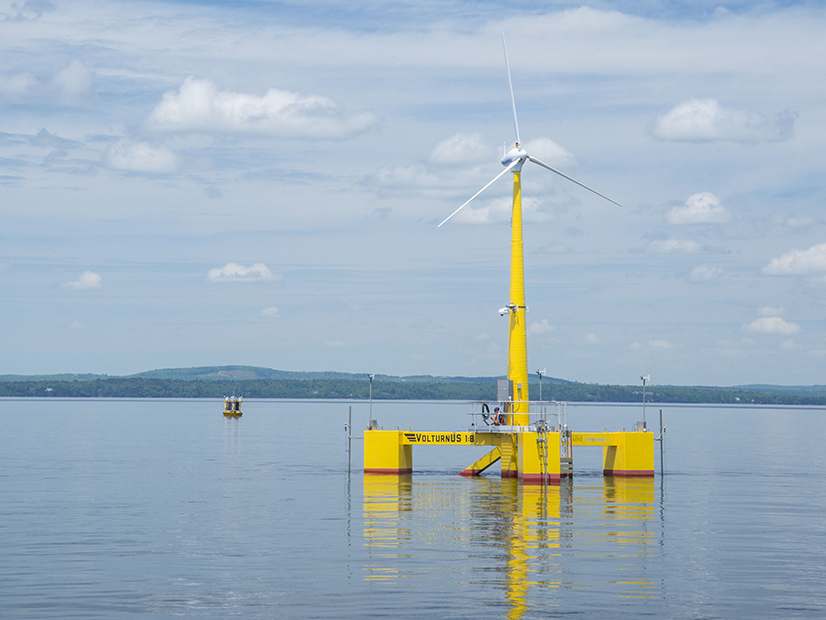
Maine is building the framework for the offshore wind sector it hopes to develop, with legislation setting a goal of at least 3 GW by 2040 and setting parameters for reaching that goal.
The measure cleared the Legislature early Wednesday and heads now to Gov. Janet Mills (D), who in June vetoed similar legislation she herself had proposed. Pro-union provisions the Legislature inserted in the measure would put the state at a disadvantage in a competitive market, she said in her veto message.
But she urged negotiation and compromise, and that is what happened.
Democrat Mark Lawrence, chair of the Maine Senate’s Energy, Utilities and Technology Committee, introduced the original compromise legislation, LD 1895, an amended version of which was approved in the special legislative session.
“It’s a great step forward for the state of Maine,” he told NetZero Insider Wednesday. “It’s going to provide a great number of jobs.”
Most of the Gulf of Maine is too deep for the fixed-bottom turbines that now are being built by the dozens and planned by the hundreds farther south along the Atlantic Coast. Maine’s goal will rely heavily on floating wind technology that still is in development and has had minimal installation anywhere in the world.
But that’s not why Maine is setting the target for 2040, years later than nearby states.
“We actually expect it to happen faster than that, but you can’t predict a lot of these things,” Lawrence said.
The measure approved Wednesday sets policy guidelines now so the regulatory framework is in place when the technology is ready for large-scale buildout.
Maine also is taking steps to speed the development of that technology, with a research and development program underway at the state university and a request working through the federal regulatory process for a research-scale floating wind farm with up to 144 MW nameplate capacity.
The state hopes to be a leader in the floating wind industry. It issued a road map in February to guide the process.
Key provisions of the legislation include:
-
- The Maine Offshore Wind Renewable Energy and Economic Development Program will be created.
- The first request for proposals will be Jan. 15, 2026, or three months after the first federal lease is issued for commercial offshore wind in the Gulf of Maine, whichever is later.
- Solicitations will specify a minimum of about 600 MW capacity but will not specify that floating wind technology is to be used; the Maine portion of solicitations coordinated with other states or entities can be less than 600 MW.
- Bidder criteria must include provisions such as diversity, equity and inclusion in employment and contracting; a fishing communities investment plan; and fisheries research, monitoring and mitigation.
- Developers will pay $5,000 per megawatt to the Offshore Wind Research Consortium Fund.
- The Public Utilities Commission must select projects that are cost-effective for ratepayers but also consider other qualitative and quantitative benefits.
- The PUC must prioritize projects that place infrastructure outside Lobster Management Area 1.
- The PUC must seek to advance regional transmission solutions to interconnect offshore wind power.
- Public work on offshore wind terminals must comply with a project labor agreement or community and workforce enhancement standards.
- Offshore wind terminals must comply with a new visual impact standard, and the Department of Environmental Protection may approve no more than four terminals.
Advocates on Wednesday were happy with the compromise.
The Natural Resources Council of Maine said: “This new law will be a model for the rest of the nation for how people can come together across differences with common purpose to build a just clean energy economy that works for everyone.”
The Maine Labor Climate Council tweeted: “ICYMI: In a major win for workers and the climate in Maine, this offshore wind bill is on the governor’s desk. When labor leads on climate, we win!”
The Business Network for Offshore Wind said: “We would like to congratulate Maine’s elected officials for coming together to pass this historic advancement of offshore wind in Maine. Once signed into law, this bill will allow Maine and the broader U.S. to become leaders in floating offshore wind technology.”
Maine Audubon tweeted: “Today, Maine’s lawmakers took a serious and measurable step toward accelerating our clean energy transition and reducing our dependence on fossil fuels.”
Maine Conservation Voters tweeted: “Maine’s clean energy future and our clean energy economy secured a major victory today. When this bill is implemented, we’ll set a national example for how to responsibly develop a new, affordable energy source, grow good-paying jobs for our workers, and do so without compromising Maine values. We’re ready to get to work and launch this new industry!”



